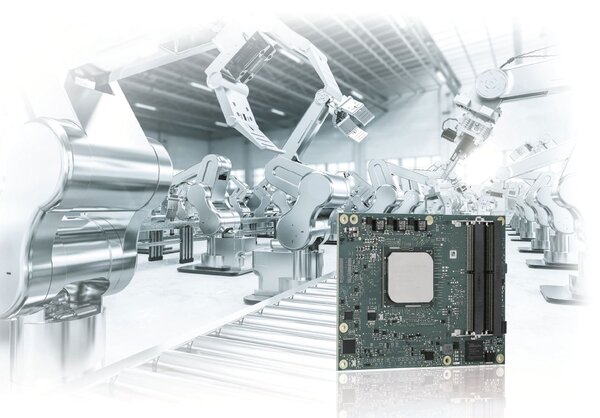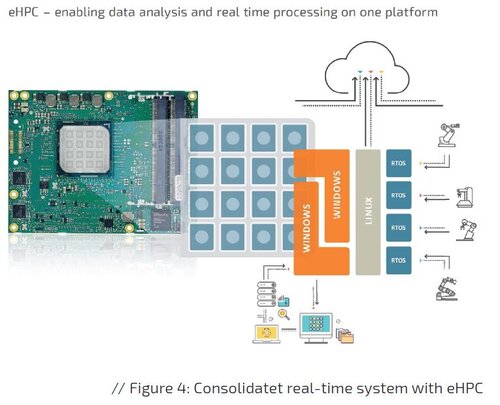
A new class of embedded high performance computing now enables real-time data processing and analysis on the very edges of the IIoT
When it comes to leveraging the potential of the industrial internet of things (IIoT), real-time processing of the huge mountains of Big Data available from numerous connected machines, devices and other assets is becoming increasingly essential.
But typical cloud computing models are not fit for purpose for IIoT applications as they are invariably hosted in data centres located considerable distances away from factory floors and other industrial environments; where the data is actually being produced. In these often harsh and remote-sited environments any delay in data transmission and analysis quickly turns potentially actionable information into ‘old news’.
Just consider a predictive maintenance application that cannot respond immediately to a potential machine problem on the production line; a windfarm control system that impacts on productivity because the turbines are too slow at responding to changing wind conditions; or an oil exploration system that cannot trigger instantaneous alerts about potentially dangerous gas build ups.
A new best of all worlds computing environment for the IIoT age
The ideal solution for the IIoT world would be a secure, resilient computing environment that bridges the gap between modern Information Technology and today’s Operational Technologies; enables scalable localised computing, resource virtualization, and supports real-time as well as less time critical computing requirements.
It’s been a tall order but the solution is now out there. It still harnesses the convenience, scalable compute, applications delivery and storage resources of the public cloud when necessary, but focuses around the delivery of powerful ‘Edge Computing’. This allows specific applications to run in close proximity to where the action is.
Bring on the Fog
Embedded edge servers provide the vital compute, storage and networking services between the end devices and centralized cloud data centres. But to do this efficiently edge servers cannot work in isolation and so are increasingly combined with what Cisco has named ‘Fog Computing’. Fog effectively extends the functionality of edge computers by bringing the cloud down to the local level, combining both centralized and distributed computing resources into a single architecture, allowing edge devices to communicate with one another and with the centralized cloud.
According to the OpenFog Consortium, the Fog architecture ideally complements the edge computing model, providing the missing link in what data needs to be pushed to the cloud, and what should be analysed locally. It brings important capabilities such as compute distribution and load balancing, hierarchical networking, virtualization support, application rightsizing, as well as increased fault tolerance and resilience.
Together, by performing much of the data processing, control and management of local applications close to the devices or sensors, Edge and Fog servers significantly reduce latency issues and applications responsiveness is optimized. For example, on a factory floor, this enables real-time processing of mission critical data necessary for triggering alerts and alarms in predictive maintenance applications, while allowing other less time sensitive data to be transmitted to the public cloud for further processing and analysis. This further reduces overall network congestion.
Embedded High Performance Computing at the Edge – exactly where it’s needed
As edge and fog servers become increasingly deployed, it has highlighted the need for a new breed of powerful embedded high performance computers (eHPC). These must deliver exceptional processing power and bandwidth to control, compute and connect multiple applications on one platform. They also need to be extremely robust to withstand harsh and sometimes extreme operating environments, while also ensuring the security of edge-based software applications.
The solution to these design challenges came last year. The PCI Industrial Computer Manufacturers Group (PICMG), of which Kontron is a longstanding member, redefined its highly popular COM Express standard (revision (3.0)) which resulted in the introduction of COM Express Type 7. This allows the design of highly scalable server-type modules offering multicore parallel processing and excellent networking capabilities on one platform.
Derived from and complementary to Com Express Type 6, the new Type 7 standard is ideally suited to maximising the multicore processing power of the latest Intel® Xeon® processor D-1500 family of system on chip (SoC) processors. The flexibility of multicore empowers system designers to assign multiple tasks on a single board computer (SBC) using dedicated processors for each one, therefore significantly increasing performance. Furthermore, the modular design approach makes it highly scalable and therefore ideally suited for meeting the increasingly demanding processing requirements of applications at the edge.
Equally important, the definition of four 10GBit network interfaces offers considerably more scope for accommodating high speed Ethernet connections, and an additional eight PCI Express lanes solves the increasing demand for connecting I/O devices with high data throughput. Other key features include NC-SI sideband signals providing the ability to perform remote diagnostics and pre-emptive maintenance activities in combination with a Board Management Controller (BMC) on the baseboard.
To accommodate these additions and changes, the Type 6 pinout was partially modified to no longer support any audio and graphics interfaces since these are largely expendable in edge-based IIoT environments. There are also only four, rather than eight USB 2.0 ports; and just two of the four SATA ports remain.
Kontron launches COM Express Type 7 eHPC family
Kontron played an active part in steering the latest COM Express Type 7 standard. As such the company has been quick to respond to IIoT edge requirements with a new powerful COM Express Type 7 eHPC module portfolio (COME-bBD7 and COMe-bDV7), providing a broad feature set and high scalability for meeting various edge-based IIoT application requirements. The COMe Evaluation Carrier T7 Board has also been newly developed especially for the Kontron COM Express Type 7 modules.
These powerful eHPC solutions also feature Kontron’s APPROTECT security solution and are the industry’s first edge server-class COMs to feature such a comprehensive on board security solution, encrypting a software application's source code in such a way that protects IP and makes reverse engineering impossible.

Additionally, the modules can be connected to an external BMC (board management controller) present on the baseboard via NC-SI (Network Connect Sideband Interface). The BMC allows monitoring of the COMe Type 7 modules and supports remote management in order to allow, for example, pre-emptive maintenance.
With our new eHPC COMe solutions Kontron is excited about our future role in helping systems architects and designers overcome the high velocity, real-time processing demands of the IIoT. We have the embedded computing technology to maximize the full potential of their edge and fog-based applications.
For further details visit our product information page on our website.
Take a look at the recorded Webinar from October 2017 ‘HIGH PERFORMANCE EDGE COMPUTING WITH COM EXPRESS TYPE 7 MODULES’


{{comment.comment}}